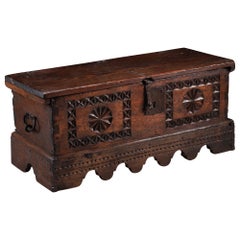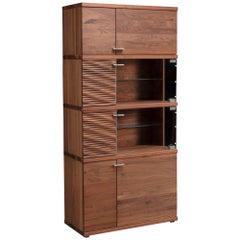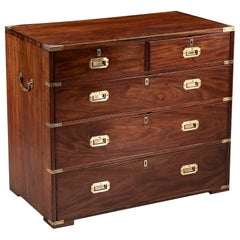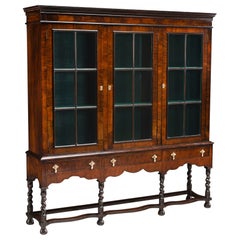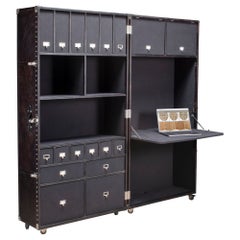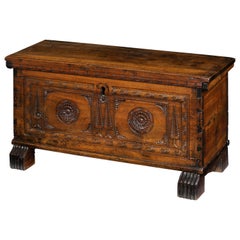Howgego Historic & Modern Case Pieces and Storage Cabinets
58
2
to
60
60
60
60
23
8
3
1
1
1
1
1
1
39
12
7
2
1
1
2
1
1
1
1
Height
to
Width
to
Depth
to
44
18
11
9
8
58
20
18
15
6
Located in BUNGAY, SUFFOLK
- Rare small size, would work as a sofa or low table with the advantage of storage space
- Characterful chip car...
Category
Antique 1720s Spanish Baroque Blanket Chests
Materials
Pine
Located in BUNGAY, SUFFOLK
Xenia, 4-tier, walnut & glazed, display cabinet or cupboard with led lighting, Venjakob, Germany
The facade comp...
Category
2010s European Mid-Century Modern Cabinets
Materials
Glass, Walnut
Located in BUNGAY, SUFFOLK
Unusual small size
Striking with the combination of richly coloured mahogany and brass
The veneers on this chest...
Category
Antique 1840s English Campaign Commodes and Chests of Drawers
Materials
Mahogany
Located in BUNGAY, SUFFOLK
Unusual, antiquarian, glazed, display cabinet or bookcase on stand in the Baroque-Style most likely made for a f...
Category
Antique Early 1900s English Baroque Revival Cabinets
Materials
Walnut
Located in BUNGAY, SUFFOLK
Travel and take your work anywhere, anytime
Funky, fun, ergonomic, mobile office, compact bureau or bookcase for...
Category
2010s Central American Campaign Desks
Materials
Chrome
Located in BUNGAY, SUFFOLK
Museum Quality, Small, Spanish, Walnut Chest With Rare Cypress Tree Carving, A Single Plank Top & Outstanding Colour & Patina
- Rare carved decoration of cypress trees alongside more traditional Spanish ornamentation
- Rare small size
- Exceptional quality and condition
- Exudes the charm and character of Spanish furniture
The single plank top with deep, crisply carved moulding below. The front with two panels, each carved with a large flowerhead roundel with carved cypress trees interposed. On later trestle base. The escutcheon and lock removed. Original pin hinges. The interior with original candle box and lid. The back with two large 'X's and the date '1849' painted in black, probably relating to an inventory or acquisition.
Provenance: Private Collection, purchased from William Job Ltd., Pimlico Road...
Category
Antique 1680s Spanish Baroque Cabinets
Materials
Walnut
Located in BUNGAY, SUFFOLK
A late-16th Century, Museum Quality, Italian Walnut & Fruitwood Marquetry Marriage Chest with a Coat of Arms & R...
Category
Antique 16th Century Italian Renaissance Blanket Chests
Materials
Fruitwood, Walnut
Located in BUNGAY, SUFFOLK
Lovely, characterful example of a good late-17th century oak chest of drawers...
Category
Antique 1660s English Baroque Commodes and Chests of Drawers
Materials
Oak
Located in BUNGAY, SUFFOLK
An exceptional, large, early-17th century, carved, oak & ebony, Flemish, statue cabinet or 'Beeldenkast' depicti...
Category
Antique 1620s Dutch Cupboards
Materials
Ebony, Oak
Located in BUNGAY, SUFFOLK
Exceptional Roman Baroque Ebonised, Rosewood Cassettone with bone inlay and magnificent brass handles
Magnifice...
Category
Antique 1690s Italian Baroque Commodes and Chests of Drawers
Materials
Bone, Ebony, Rosewood
Located in BUNGAY, SUFFOLK
The serpentine front on this magnificent commode is sophisticated and gives it gravitas. The undulating form is ...
Category
Antique 1720s Italian Baroque Commodes and Chests of Drawers
Materials
Walnut, Burl
Located in BUNGAY, SUFFOLK
AN EXCEPTIONAL, LATE GEORGIAN, GOTHIC-REVIVAL BOOKCASE WITH CHARACTERISTIC GOTHIC DETAILING AND STUNNING OAK FIGURING
-This is a cabinet piece of extremely high quality, the oak employed has exceptional figuring and medullary rays and it has a lustrous patina and rich mellow color.
-It is large but not massive so it would not overpower an interior.
-It is in excellent condition and can accommodate a large volume of books.
-The lower cupboard section is very useful for storing books or items that need to be concealed.
-All the doors have working locks and one key serves the top part and another the bottom.
-It is in fabulous original condition
This is an exceptional Gothic-Revival bookcase dating from the mid-19th century. It is a cabinet piece of extremely high quality, the oak employed has exceptional figuring and it has a lustrous patina and rich mellow color. It is large but not massive so it would not overpower an interior. It is in excellent condition and can accommodate a large volume of books. The lower cupboard section is very useful for storing books or items that need to be concealed.
In three horizontal sections, cornice, upper glazed bookcase and lower cupboard. The upper glazed bookcase in two parts, a right hand side double bookcase and left hand side single.
The detachable cornice with an ogee moulding above a deep frieze.
The bookcase divided into three sections, each with six panels with original glazing and gothic arches at the top. The interior with numerous fittings for shelves. The doors with original escutcheons, locks and a replaced steel key that operates all the upper bookcase locks.
The cupboard section with a 3cm thick top and divided into three sections. The oak doors have beautiful and profuse medullary ray figuring resembling a burr which the cabinet maker has selected to match and Gothic motifs in each corner and at the top of the interposed moulded panels. The interior divided into three enclosed sections each fitted with a single shelf. Original escutcheons, locks and replaced steel key operating all the cupboard base locks.
The sides with exceptional medullary ray figuring.
On a plinth base.
The carcass pine.
Twelve Pine Shelves faced with oak reeding...
Category
Antique Mid-19th Century British Gothic Revival Bookcases
Materials
Oak
Located in BUNGAY, SUFFOLK
Exceptional museum quality, Italian, renaissance walnut cassettone with fitted bureau in the upper part & exceptional Bambocci carving, Lombardy.
This magnificent cassettone exudes the character and quality of the finest, late-Renaissance furniture. Late 16th century, Northern Italian furniture often had the sides, legs or angles, 'a Bambocci', incorporating carved figures which were unique sculptures in their own right. The putti on this cassettone are beautifully carved and of sculptural quality. Each angel has one arm raised to heaven, a poignant touch. Showing customary signs of wear from time, the lion’s paw feet make a great statement. This cassettone was conceived to have visual impact through the quality of the carving, as well as being very practical with the writing compartment fitted in the top part. It has survived in very original condition with a few small repairs and losses, and the color and patina are warm and lustrous. This cassettone was illustrated in one of the seminal works on Lombardy furniture in the 1969 and has been in two renowned collections.
The hinged top in two sections faced with a solid moulded edge. The front part has a fall front and opens to reveal a writing compartment. The fall front retains its original lock and is concealed with a false drawer which is above three drawers. All with moulded panels, escutcheons and retaining the original iron handles. The front ends have exceptional, bambocci, carved putti raising their arms to heaven above trailing foliage. Standing on magnificent lion...
Category
Antique 16th Century Italian Baroque Furniture
Materials
Walnut
Located in BUNGAY, SUFFOLK
A rare, inlaid Court cupboard bearing the initials RR & KL and the date 1731 suggesting this is a commemorative ...
Category
Antique 18th Century English Baroque Cupboards
Materials
Fruitwood, Oak, Sycamore, Walnut
Located in BUNGAY, SUFFOLK
A rare, late-17th century / early-18th century, fall front bureau with gilded Chinoiserie Japanning & faux tortoishell ground.
“Before Japan was made in England, the imitation of tortoise-shell was much in request for cabinets, tables and the like“. John Stalker and George Parker, a treatise on Japanning and varnishing (originally published in 1668), Alec Tiranti, 1998, p. 75.
- This bureau is decorated in one of the most fashionable styles of the Baroque period, Chinese lacquer with gilded decoration and tortoiseshell imitation ground and would have been a statement piece within the interior.
- The colours, which have become muted from atmospheric conditions over time, are still striking and colourful evoking warm and richness.
- It has come from a private collection where it has reputedly been for many generations which explains why it is in such original condition retaining the original hinges, lock and catches.
- Pieces of imitation tortoishell with gilded lacquer decoration are rare, the last piece I handled was a chest of drawers about 20 years ago.
- Tortoishell furniture was only affordable by royalty and the elite and the height of fashion in the 17th century, as was producing things that were not what they seemed. One of the oldest examples of faux material from the Baroque period is at Rosenborg Castle in Copenhagen where, in 1667, the royal bed...
Category
Antique 17th Century Italian Chinoiserie Desks
Materials
Lacquer
Located in BUNGAY, SUFFOLK
- Really unusual, characterful conversation piece of military/aeronautical history ex British Army or Air Force
...
Category
20th Century English Mid-Century Modern Blanket Chests
Materials
Wood
Located in BUNGAY, SUFFOLK
An exceptionally rare, museum quality Maltese, Neoclassical walnut chest of drawers with ebonised & fruitwood inlaid maltese cross on the top and drawer fronts
Maltese furniture of this period is exceptional reflecting the status and affluence of the island.
Given the size of the island relatively little Maltese furniture was made in comparison to Europe & American mainland.
Minature furniture is rare made either as a model or an apprentice's piece so it is extremely rare to find a minature piece from Malta bearing the Maltese cross.
This minature commode is highly original with beautiful proportions, ornamentation and patination.
The 'H' shaped top with a large centered inlaid Maltese Cross and a border of stringing. The breakfront fitted with three drawers each with stringing and inlaid six point stars centrally positioned behind the wooden knobs. The uprights with two continuous vertical bands of stringing ebonised and fruitwood from the top to the bottom of the drawers in walnut to match the front of the chest and then reverting to ebonising and fruitwood down the feet. Terminating in tapering feet. The panelled sides with a repeat of the double banding on the uprights and rectangular borders within the panels. The oak lined drawers with the original 18th century blue paper lining.
Measures: length 27 cm 10 1/2", height 24 cm 9 1/2", depth 20 cm 8".
Maltese Cross:
The Maltese cross is a symbol that is most commonly associated with the Knights of Malta (also known as the Knights Hospitallers...
Category
Antique 18th Century Maltese Neoclassical Commodes and Chests of Drawers
Materials
Fruitwood, Walnut
Located in BUNGAY, SUFFOLK
Dual purpose can serve as a safe and sidetable
Stylish conversation piece for the interior
The central bar locks...
Category
20th Century English Side Tables
Materials
Metal
Located in BUNGAY, SUFFOLK
Long black metal trunk, bearing brass label inscribed 'J E Holmes Esq, Volunteer Artillery'. Metal carrying hand...
Category
Antique 19th Century English Victorian Trunks and Luggage
Materials
Metal
Located in BUNGAY, SUFFOLK
A matched pair of 19th century black metal travelling trunks. Metal carrying handles. Locks no keys. One stamped made in England. Both with Union-Castle Line & Safmarine, G, Mr & Mrs Gale, Cabin 151 & 155, Vessel SA Oranje, 7th April, Port of Embarkation Southampton, Port of Disembarkation Cape Town
Both with S.A.R. S.A.S. labels numbered 58
One with South African Railways Label
One marked 'No III'
Wonderful deep and rich patina reflecting their history from years of travel
Can be repurposed as chests on stands in the bedroom or hallway or as decorative objects.
each trunk Length 70 cm., " Depth 40 cm., Height 24 cm.
Union-Castle Line & Safmarine,
The Union-Castle Line was a British shipping line...
Category
Antique 19th Century English Victorian Trunks and Luggage
Materials
Metal
Located in BUNGAY, SUFFOLK
A characterful 19th century, domed, overseas, travelling, steamer, trunk in canvass with leather trim, handles and brass hardware with lock. No key. The exposed straps removed. Bearing an old Southern Railway paper label no 2812 from Dover Priory and remains of numerous travel labels...
Category
Antique 19th Century English Victorian Trunks and Luggage
Materials
Leather, Canvas
Located in BUNGAY, SUFFOLK
A fine, high quality leather suitcase, the top leather embossed 'JGV', with reinforced corners, leather handle and brass hardware, the lock stamped 'EHOFMANN 11457' No key. The inside with brass label 'To Dr John...
Category
20th Century German Art Deco Trunks and Luggage
Materials
Nickel
Located in BUNGAY, SUFFOLK
A fine, 19th century, high quality, leather, overseas, travelling, steamer suitcase with exposed straps, handles and brass hardware with lock stamped with a crown and 'VR (Victoria Rex) patent' and key. Bearing brass owners label incised 'J Tully' and the front embossed 'Warrantied Solid Leather'. Original blue and white ticking and leather interior with straps and internal folding divider and compartments. Bearing maker's label 'J C Sweeney, manufacturer of portmanteaus, trunks, India overlands, ladies boxes, travelling bags, hat cases...
Category
Antique 19th Century English Victorian Trunks and Luggage
Materials
Leather
Located in BUNGAY, SUFFOLK
A fine large 19th century, thick, high quality leather overseas travelling trunk with reinforced exposed straps,...
Category
Antique 19th Century English Victorian Trunks and Luggage
Materials
Nickel
Located in BUNGAY, SUFFOLK
A STRIKING, MUSEUM QUALITY, BAROQUE, PORTUGUESE BRAZILIAN, ROSEWOOD & VINHÁTICO CONTADOR OR CABINET ON STAND WIT...
Category
Antique 1650s Portuguese Baroque Cabinets
Materials
Brass
Located in BUNGAY, SUFFOLK
A large, museum-quality, late-16th century, cedar, Venetian, cassone on its original stand ; the sea creature ornament probably drawn from De la Cosmographie Universelle, livre III, engraving 1550-1568
• This is the only, known, cassone of this type retaining its original stand.
• The collection in Italy that it originally came from was a palazzo that it had reputedly been in for generations of the same family and this most likely why the stand has survived.
• The decoration is very unusual, and delightful in the array of sea creatures depicted. The connection of the region with the sea is very strong.
• The inner lid is very practical and can be used for display or serving. The interior offers masses of storage space which is particularly suitable for textiles being cedar which repels moths.
• The cassone is a beautiful, rich colour and has developed a lustrous patina.
• The cassone is Illustrated & discussed in discussed in ‘Woods in British Furniture Making’, (Bowett) c13
Provenance: Private collection, Mayorca. Private collection, Italy
Related to: Cassone in V&A collection, no 4886-1858
Width 177 cm., 70 in., Height 87 cm., 34 ½ in. Depth 68 cm. 26 ½ in.
With lid open 155 cm., 61 in
“Late 16th and 17th century, London inventories confirm that cypress wood chests were relatively common in prosperous households. In 1598 there was a cypress chest in the hall of John Mason, a vintner, valued at 50 shillings. It was the most expensive piece of furniture in the house. Similarly there was a ‘fair cypress chest’ in the great chamber of Adrian Moore, haberdasher, in 1618, and a cypress chest worth £ 9 in the hall of Thomas Willis, a clotherworker in 1630. The chests were sometimes described as ‘great’ or ‘small’ but not otherwise described – presumably they were familiar to the compilers of the inventories. They were placed in halls, chambers and parlours, places where they would have been on prominent view. It is noteworthy that only the chests were imported and not, apparently, the wood. “ (p282, Cypress, Woods in British Furniture making)
The decoration is very unusual, and delightful in the array of sea creatures depicted. The connection of the region with the sea is very strong. I have never seen one of these chests on its original stand. The collection in Italy that it came from was a palazzo that it had reputedly been in for generations of the same family and this most likely why the stand has survived. In practical terms, the stand makes the chest a comfortable height to use. The exterior of the chest is a beautiful, mellow colour and has developed a lustrous patina.
The top comprises three planks faced with a shallow, cleated, moulded edge nailed on. The front retains its original hasp and lockplate and, as is commonly found, the lock has been removed but, unusually the original ring hinges have survived. The top opens to reveal an inner lid with ring hinges and a brass ring, revealing a large open storage compartment below, the bottom lined with an old fabric. The underside of the lid retains its original penwork and pierced decoration. The central panel depicts sea creatures, sharks, flatfish, monster fish, sea horses, Neptune and mermaids, probably drawn from De la Cosmographie Universelle, livre III, engraving 1550-1568. The panels either side depicting a crown, the sun and unicorns amongst stylised floral sprays. The surrounding naive penwork border features repeats of three naked ladies in the sea, a man wearing an animal mask with two dogs in a forest and a huntsman with two dogs. The floor of the inside of the cassone is upholstered in an 18th century red and yellow striped woven textile the colours of the Catalan flag. The front is decorated with pierced, silhouettes of beasts, trees and figures. The sides are plain with iron carrying handles. On its original stand, with similar decoration, and bearing a cartouche which would have been decorated with the arms of its original owner. Italian, last quarter of the 16th century.
Condition Report : Old repair to bottom left moulding of top. Some hairline cracks to top. The hasp, lockplate and ring hinges are original, the lock has been removed. Handles probably 18th century. The inner lid was probably added in the 18th century and supporting mechanism in the 19th century. Exceptional original, lustrous colour and patina.
Measures: Width 177 cm. 70 in., height 87 cm. 34 ½ in., depth 68 cm. 26 ½ in.
The cassone was the principal piece of furniture in 16th century, Italy. These chests were made as bridal gifts for nobles and aristocrats from cedar specifically for storing their much prized and valued hangings, clothing and linens, as the wood repels moths and the sweet fragrance delicately scents fabrics. Consquently the cassone, as in this example might be decorated with the family coat of arms or with depictions of virtue and edifying episodes from the Bible. A young woman could not be allowed to enter marriage without some instruction. Later, many cassoni were taken apart so that the decorated front panel could be hung as a painting. The stand of this cassone has a cartouche that would have contained a painted coat of arms in the centre which shows that it was conceived for a noble family. Such cypress or cedar chests, incised in bas relief and pyrographically engraved, have long been associated with Venice and typically have a naïve decoration on the exterior.
Literature:
The 'cypress chests' containing 'arras, counterpoints, costely apparel, tents, and canopies, fine linen, Turkey cushions...
Category
Antique 16th Century Italian Renaissance Cabinets
Materials
Cedar
Located in BUNGAY, SUFFOLK
- Rare 17th century interpretation of a Gothic cupboard
- Probably made for family living space due to unusual, small proportions with narrow size and height or made to store expensive, luxury, items
- Lovely color and patina
Top in two sections with a solid moulded edge. The front with an upper cupboard with door with linenfold panel...
Category
Antique 1610s French Cupboards
Materials
Oak
Located in BUNGAY, SUFFOLK
Venetian, baroque, small, walnut, Inginocchiatoio, table, chest or kneeler with a rule along the right lower end...
Category
Antique 1680s Italian Baroque Commodes and Chests of Drawers
Materials
Walnut
Located in BUNGAY, SUFFOLK
- Particularly fine example with deep cushion and geometric mouldings.
- Atmospheric piece with character
- Se...
Category
Antique 1650s English Baroque Cabinets
Materials
Fruitwood, Oak, Cedar
Located in BUNGAY, SUFFOLK
- Fine, elegant, Chippendale period bedside table
- Practical for everyday use
- Finely figured tray top is prac...
Category
Antique 1760s British George III Tray Tables
Materials
Mahogany
Located in BUNGAY, SUFFOLK
- Elegant, classical form
- Conversation piece
- Perfect height for sofa or bedside table
The hinged moulded to...
Category
Antique 1830s English Early Victorian Commodes and Chests of Drawers
Materials
Mahogany
Located in BUNGAY, SUFFOLK
- Stunning plum pudding veneers, colour and patina.
- Perfect height for a sofa table, or bedside
- Unusual scro...
Category
Antique 1830s English Early Victorian Commodes and Chests of Drawers
Materials
Mahogany
Located in BUNGAY, SUFFOLK
- Charming and characterful nautical design
- Depicting a fleet of five galleons or warships at anchor in a bay...
Category
Antique 1870s French Baroque Revival Decorative Boxes
Materials
Brass
Located in BUNGAY, SUFFOLK
An early 17th century, Flemish, Malines, ebonized and alabaster cabinet with removable sliding sides revealing s...
Category
Antique 1630s Belgian Baroque Cabinets
Materials
Alabaster
Located in BUNGAY, SUFFOLK
- Unusual eye-catching, characterful cupboard for a bootroom, hall or tackroom
- Fun equestrian interest
The...
Category
Vintage 1970s English Folk Art Cupboards
Materials
Wood
Located in BUNGAY, SUFFOLK
A large, museum quality, 18th century, German, oak bureau bookcase with a serpentine front, original brassware a...
Category
Antique 1740s German Rococo Desks
Materials
Oak
Located in BUNGAY, SUFFOLK
Rare, early 17th century, Spanish, leather, ‘Arcon’ or domed travelling coffer with a gilded armorial & ornament...
Category
Antique 1620s Spanish Baroque Blanket Chests
Materials
Leather
Located in BUNGAY, SUFFOLK
Rare, small, late-Renaissance, Nuremberg, iron, 'armada box', strongbox or travelling ...
Category
Antique 16th Century German Renaissance Arms, Armor and Weapons
Materials
Iron
Located in BUNGAY, SUFFOLK
A museum quality, English, Late-Renaissance, cedar enclosed chest of drawers with exceptional snakewood, walnut & oak with an architectural or façade front
This is the most sophisticated English model of chest of drawers conceived as a cabinet piece with an architectural front intended to disguise the drawers. This chest exhibits the mastery of English Late-Renaissance, cabinet making combining woods prized for their exoticism, color and beautiful figuring with carving and moulding in different ornamental patterns to simulate materials found within an architectural façade...
Category
Antique Early 17th Century European Renaissance Commodes and Chests of D...
Materials
Cedar
Located in BUNGAY, SUFFOLK
An exceptionally rare, late-Renaissance, Florentine, walnut, writing cabinet, scrittoio, escritoire or desk in t...
Category
Antique Early 1600s Italian Renaissance Cabinets
Materials
Walnut
Located in BUNGAY, SUFFOLK
This is a fine example of a Renaissance period credenza or sideboard that would have been made for an Italian Pa...
Category
Antique Early 1600s Italian Renaissance Credenzas
Materials
Walnut
Located in BUNGAY, SUFFOLK
Exceptional, early 17th century, Spanish, leather, ‘Arcon’ or domed travelling coffer ornamented with brass stud...
Category
Antique 1620s Spanish Baroque Blanket Chests
Materials
Leather
Located in BUNGAY, SUFFOLK
This rare cassettone oozes charm and character. The carved decoration is particular to Brescia in Lombardy and t...
Category
Antique Late 17th Century Italian Baroque Commodes and Chests of Drawers
Materials
Walnut
Located in BUNGAY, SUFFOLK
Designer : Gilbert Rohde
Model ; Dresser 4041 Honeymoon Furniture for Young America,
Maker : Kroehler
Exhibited : 'America at Home' at the New York World's Fair 1940.
Created by Gilbert Rohde, 1940's foremost furniture designer, expressly to demonstrate modern living displayed in the 'America at Home' building at the New York World's Fair 1940.
Honeymoon furniture by Kroehler is outstanding in contemporary furniture design.
Notice its space saving compactness, its sturdiness, its freedom from dirt catching corners.
Honeymoon furniture offers comfort, convenience and economy never before possible in the small home or apartment
The use of two different coloured woods to create a two-tone effect is very striking and complements the simple form. This unusual chest of drawers is a signature piece that injects character into any interior.
The raised sides sit proud of the top elevating the chest creating an elegant tray effect. The front is fitted with three drawers with original wooden knobs in contrasting dark brown laurel. The sides have a projecting section of contrasting dark brown laurel at the front which defines the form. Inverted triangular feet. "Kroehler Made" metal tag. Designer unknown.
Kroehler
In 1902, Peter E. Kroehler bought the Naper ville Lounge Co., a maker of wooden lounge chairs and upholstered furniture. Kroehler built a new factory in Naperville in 1913 after the original facility was destroyed by a tornado. Soon thereafter, he renamed the company Kroehler Manufacturing Co. This enterprise soon operated across the country and employed several hundred men and women in the Chicago area. By the middle of the 1940s, with over $20 million in annual sales, Kroehler was the second-largest furniture maker in the United States. During the 1960s, when the company employed close to 8,000 people around the country, annual revenues passed $100 million. The company struggled during the 1970s, closing its historic Naperville factory in 1978 and ending its operations in the area. In 1981 Kroehler was acquired by the ATR Group of Northbrook, which put the company up for sale. By the early 2000s, furniture was still manufactured under the Kroehler name by two unrelated companies, one in North Carolina and the other in Ontario, Canada.
Gilbert Rhode : American, 1894 - 1944
Gilbert Rohde (1894-1944) is best known for helping to create the modern design at Herman Miller Inc. Gilbert Rohde furniture design was focused on mass production and bringing modern products to the greatest number of consumers. He is also credited with designing the first examples of biomorphic furniture in America-which would ultimately shape mid century modernism.
US industrial designer, born in New York. He became familiar with cabinetmaking in his father's shop. He studied at the Art Students League and Grand Central School of Art in New York. Early work was as a drama and music critic, cartooninst, reporter, and furniture illustrator. He traveled to France and Germany in 1927 and was inspired by modernism.
He opened his own office in New York in 1927, designing furniture and showrooms, and consulting with manufacturers like General Electric and Hudson Motor Car Company.
In 1931 HeywoodWakefield Company introduced a compact armless leatherette side chair with bentwood rear legs designed by Rohde, which sold 250,000 over the next eight years. Rohde also developed a later version for the Herman Miller Furniture Company, which was sold dis-assembled and made by what Rohde called an "automobile type of assembly."
By 1929 he had established a relationship with D.J. Depree, president of the Herman Miller Furniture Company in Zeeland, MI and prepared some designs for him. Dupree appointed him director of design there in 1932 as part of his decision to shift the company’s orientation from traditional to modern design. His first modern design for the company, a No. 2185 Group bedroom suite was shown at the Chicago Century of Progress.
Also in 1932, Rohde exhibited his furniture designs in a "Design for Machine" exhibit in Philadelphia, along with designs of Russel Wright. The Herman Miller Clock...
Category
Vintage 1950s North American Mid-Century Modern Commodes and Chests of D...
Materials
Birdseye Maple
Located in BUNGAY, SUFFOLK
The top fitted with a removable gallery with fine brass filigree depicting lion heads and crowns amongst trailin...
Category
Antique Early 19th Century English Regency Desks
Materials
Mahogany
Located in BUNGAY, SUFFOLK
Lovely cassone with classical form, the beautiful figuring of the oak creates subtle, decorative patterning and ...
Category
Antique Late 17th Century French Louis XIV Blanket Chests
Materials
Walnut
Located in BUNGAY, SUFFOLK
Serpentine-shaped ottoman, mid-19th century, English, Victorian, with mahogany skirt and feet and upholstered in...
Category
Antique Mid-19th Century English Victorian Blanket Chests
Materials
Leather
Located in BUNGAY, SUFFOLK
This striking chest is made from a Brazilian hardwood which I have not been able to identify. The color and figu...
Category
Antique Late 17th Century Portuguese Baroque Blanket Chests
Materials
Hardwood
Located in BUNGAY, SUFFOLK
I have never seen a desk like this before, it is really quirky, a great conversation piece.
Tan leather top wit...
Category
Vintage 1980s English Post-Modern Desks
Materials
Mahogany, Giltwood
Located in BUNGAY, SUFFOLK
This vernacular chest exudes character and charm. The moulded panels and inlay inject gravitas. It has a lovely ...
Category
Antique Early 17th Century German Baroque Blanket Chests
Materials
Oak
Located in BUNGAY, SUFFOLK
This handsome cassone has ornament with romantic associations and was most likely a marriage chest. It is a good...
Category
Antique Late 17th Century Italian Baroque Blanket Chests
Materials
Walnut
Located in BUNGAY, SUFFOLK
This charming and unusual casket injects a romantic atmosphere into any interior. It has survived in impeccable condition with acceptable wear to the painted surface which signifies its age and use. It is a conversation piece, a piece of acting history, bought by Vivien Leigh and Laurence Olivier...
Category
Antique Mid-17th Century German Baroque Decorative Boxes
Materials
Oak
Located in BUNGAY, SUFFOLK
Spanish writing desks of this period are the most distinctive pieces of Spanish furniture conceived as visual di...
Category
Antique Early 17th Century Spanish Baroque Cabinets
Materials
Walnut
Located in BUNGAY, SUFFOLK
This is a fine vernacular piece with simple but bold ornamentation and a rich lustrous patina.
The top with ...
Category
Antique Late 17th Century European William and Mary Corner Cupboards
Materials
Oak
Located in BUNGAY, SUFFOLK
The serpentine front on this magnificent commode is sophisticated and gives it gravitas. It has a rich colour an...
Category
Antique Early 18th Century Italian Baroque Commodes and Chests of Drawers
Materials
Walnut
Located in BUNGAY, SUFFOLK
This Classic 18th century model is a rare, small size with a rich color and lustrous patina. From a private collection, Semenzato, Venezia.
Single plank top with solid moulded edge. The frieze with a band of gadrooned carving at the top. Below three drawers mouled with fine figuring original brass handles, escutcheon and locks only the top lock working. The pine drawers are lined with a block printed...
Category
Antique Early 18th Century Italian Baroque Commodes and Chests of Drawers
Materials
Walnut
Located in BUNGAY, SUFFOLK
This cabinet was made in Flanders in the mid-17th century as a prestigious item for an affluent member of the pr...
Category
Antique Mid-17th Century European Baroque Cabinets
Materials
Tortoise Shell
Located in BUNGAY, SUFFOLK
This cabinet is one of a small group that were made in the 1620s as taste and fashion veered towards the use of ...
Category
Antique Early 17th Century Italian Baroque Cabinets
Materials
Marble
Located in BUNGAY, SUFFOLK
This standing chest is of clamp-front construction, extensively decorated with long, ironwork straps with quatrefoil finials which ‘wrap’ around it, and has an ornate, central lockplate, and front legs with full, height stiles. The ironwork straps and finials are fixed with convex, headed nails: running along the front, five long straps; the two side straps; and the five straps on the top. On the chest front, centrally placed, is a large, iron lockplate with four outer, radiating spade finals in each corner and three, superimposed spade finials (a symbol of nobility) which are pierced with the initials ‘BB’. The lockplate receives a corresponding, external hasp fitted to the lid. Below the floor of the chest, the two front stile legs retain most of their original height. The lid is supported by substantial iron strap hinges that extend right down the back of the chest. Inside the chest at the left end is a shallow, oak till.
Construction The chest is of joined, 'clamp-front' construction, reinforced by the nailed, iron mounts. In total it uses ten, oak boards which were riven and planed. The back and front are each formed from a large single plank held to the full height stiles by long, pegged tenons. The sides are also single boards joined into the stiles using long tenons held by dowels, and extend down below the chest bottom, concealing the ends of the bottom boards. The bottom consists of a single board cut into the sides and shallow rebates in the stiles. The front and back boards are dowelled into the bottom boards. The lid which overhangs the sides has a narrow cleat at each end, and consists of one wide plank which has bowed a little as a result of shrinkage.
Ironwork : The wrought ironwork straps, lockplate, hasp and lock all appear all appear to be early, and of the same original manufacture and are fixed with convex headed nails. There is mild dark staining of the oak around the iron mounts, possibly because of low tannin content in the oak.
Length 172 cm., 67 ¾ in., Height 71.5 cm., 28 ¼ in., Depth 63 cm., 24 ¾ in.,
Related to: No 900:2-1904 V&A Museum, London. Stadtmuseum Dusseldorf. Decorative Arts Museum Berlin. Museen Schleswig-Holstein & Hamburg. A related example featuring elaborately-carved feet and formerly in the Horsham Museum, West Sussex, sold at Christie's in 2010 for £97,250 and another example, again with carved feet sold at Sothebys in 2006 for £48,000.
Literature: A similar example is illustrated in H. Lüttgens, Alt- Aachener Wohnkultur; Ein Rundgang durch ein altes Aachener Haus im Wohnstil des 18. Jahrhunderts, Aachen, n.d., ill. 12, and another comparable iron-bound chests...
Category
Antique 16th Century German Gothic Blanket Chests
Materials
Oak
Located in BUNGAY, SUFFOLK
AN EXCEPTIONAL MUSEUM QUALITY, ITALIAN, RENAISANCE WALNUT CASSETTONE WITH A FITTED BUREAU IN THE UPPER PART & EXCEPTIONAL BAMBOCCI CARVING, LOMBARDY
- This exceptionally rare, museum quality, piece of early furniture was conceived and crafted as an artwork of the finest quality of its time. Throughout time it has been a luxurious, statement piece which has protected it, and fortunately it has survived in virtually, original condition.
- This magnificent cassettone exudes the character and quality of the finest, late-Renaissance furniture.
Northern Italian Renaissance furniture often had the sides, legs or angles, 'a Bambocci', incorporating carved figures which were considered unique sculptures in their own right.
- The putti on this cassettone are beautifully carved and of sculptural quality. Each angel has one arm raised to heaven, a poignant touch.
- The lion’s paw feet are a classical feature and make a great statement.
- This cassettone was conceived to have visual impact through the quality of the carving, as well as being very practical with the writing compartment fitted in the top part.
- It has survived in very original condition with a few small repairs and losses, and the colour and patina are warm and lustrous.
- This cassettone is illustrated Illustrated in C. Alberici, Il Mobile Lombardo, Milan, 1969, p. 45, one of the seminal works on Lombardy furniture, and has been in two renowned collections.
The hinged top in two sections faced with a solid moulded edge. The front part has a fall front and opens to reveal a writing compartment. The fall front retains its original lock and is concealed with a false drawer which is above three drawers. All with moulded panels, escutcheons and retaining the original iron handles. The front ends have exceptional, bambocci, carved putti raising their arms to heaven above trailing foliage. Standing on magnificent lion's-head carved feet. The sides are panelled. Exceptional original colour and patina.
Literature : Illustrated in C. Alberici, Il Mobile Lombardo, Milan, 1969, p. 45. A Gonzalez-Palacois, Il mobile in Liguria, Genova, 1996 illustrates related pieces
Measures: Length 147 ½ cm. 58 in, height 104 cm. 41 in, depth 75 cm. 29½ in,
Provenance: Coll. Private Azzate The Collection of Sandro and Lidia Orsi, Ca’ Mera, Varese. Regarded as one of the most beautiful homes in Lombardy, Ca’ Mera, the country house of Sandro and Lidia Orsi was filled with beautiful objects from many different epochs. A renowned antiquarian from Milan, over his lifetime Sandro and his wife Lidia revived the Renaissance and Baroque character of the house and instilled their own unique vision into the interiors, which culminated with the creation of a Kunst – or Wunderkammer. “I have never seen such an example of poetical taste”, Sir John Pope...
Category
Antique 16th Century Italian Renaissance Commodes and Chests of Drawers
Materials
Walnut
